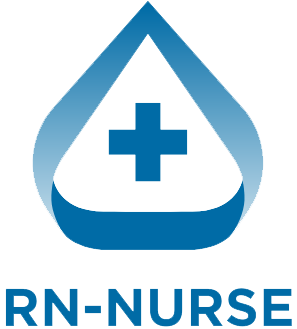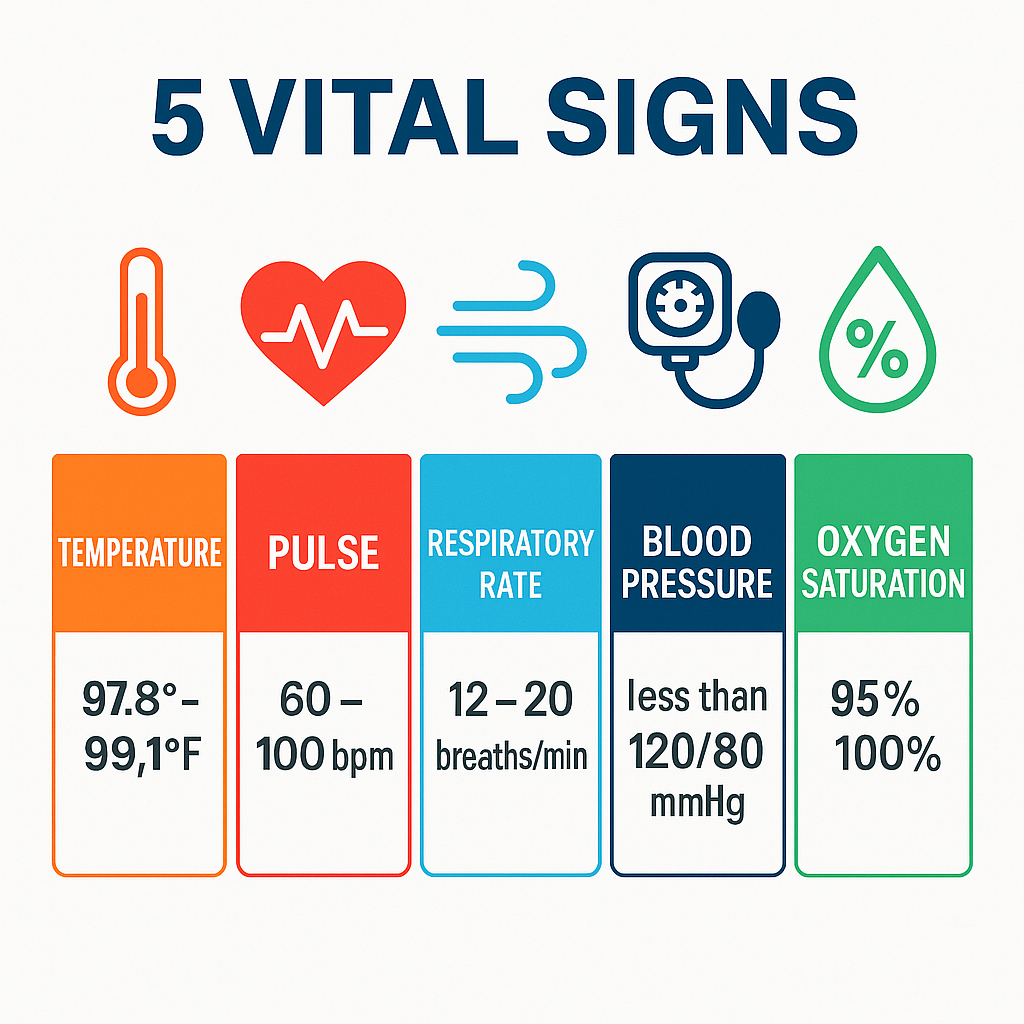Checking vital signs is one of the first things every nurse learns. But doing it right — and understanding what the numbers mean — is what makes you a safe, confident caregiver.
This simple guide will help you measure each vital sign step-by-step, know what normal and abnormal values mean, and spot when your patient needs help fast.
🩺 What Are Vital Signs?
Vital signs are key numbers that show how well the body is working. They tell you about blood circulation, breathing, temperature, and sometimes pain.
The 5 basic vital signs are:
1️⃣ Temperature (T)
2️⃣ Pulse (P)
3️⃣ Respiratory rate (RR)
4️⃣ Blood pressure (BP)
5️⃣ Oxygen saturation (SpO₂)
Many nurses also include pain as the “6th vital sign.”
🌡️ 1️⃣ Temperature
What it shows:
Body temperature helps you find fever, infection, or heat loss.
Normal range:
- 97.8°F to 99.1°F (36.5°C to 37.3°C)
How to measure:
- Oral (under tongue) — common for adults.
- Axillary (under arm) — easy but less accurate.
- Tympanic (ear) — quick for kids.
- Rectal — most accurate, often for babies.
What’s abnormal:
- Fever: > 100.4°F (38°C) → may mean infection.
- Hypothermia: < 95°F (35°C) → may mean cold exposure, shock, or sepsis.
Nursing tips:
- Wait 15 minutes after hot/cold drinks for oral temp.
- Always compare to patient’s normal baseline.
❤️ 2️⃣ Pulse (Heart Rate)
What it shows:
Heartbeats per minute show how well the heart pumps blood.
Normal range:
- Adults: 60–100 bpm
- Athletes: may be lower
- Children: higher than adults
How to measure:
- Use index and middle fingers (not thumb).
- Count for 30 seconds and double it.
- Common sites: radial (wrist), carotid (neck), apical (stethoscope over heart).
What’s abnormal:
- Bradycardia: < 60 bpm (can be normal for athletes)
- Tachycardia: > 100 bpm (may mean fever, pain, dehydration)
Nursing tips:
- If irregular, count a full minute and listen apically.
- Check for strength and regularity, not just number.
🌬️ 3️⃣ Respiratory Rate
What it shows:
Breaths per minute show how well the patient is breathing.
Normal range:
- Adults: 12–20 breaths/minute
How to measure:
- Watch chest rise and fall.
- Count for 30 seconds quietly (patients may breathe differently if they know you’re counting!).
What’s abnormal:
- Bradypnea: < 12 (may mean sedation, drug overdose)
- Tachypnea: > 20 (may mean fever, pain, anxiety, or lung issues)
Nursing tips:
- Look for signs like labored breathing, cyanosis, or use of neck muscles.
💉 4️⃣ Blood Pressure
What it shows:
How much pressure blood puts on artery walls — tells you about circulation and heart health.
Normal range:
- Systolic: 90–120 mmHg
- Diastolic: 60–80 mmHg
How to measure:
- Patient resting, arm at heart level.
- Correct cuff size.
- Inflate cuff, listen for Korotkoff sounds.
What’s abnormal:
- Hypertension: > 140/90 mmHg (long-term → stroke, heart disease)
- Hypotension: < 90/60 mmHg (may mean shock, dehydration)
Nursing tips:
- Always compare to patient’s normal BP.
- Check both arms for differences.
- Recheck manually if automatic reading seems wrong.
🫧 5️⃣ Oxygen Saturation (SpO₂)
What it shows:
How much oxygen the blood carries.
Normal range:
- 95%–100% on room air.
How to measure:
- Use a pulse oximeter on fingertip, earlobe, or toe.
What’s abnormal:
- Hypoxia: < 90% (may mean lung or heart trouble)
Nursing tips:
- Cold fingers or nail polish can affect readings.
- Compare to patient’s baseline, especially for COPD patients.
😣 Bonus: Pain as the 6th Vital Sign
Why it matters:
Pain affects heart rate, BP, and recovery.
How to measure:
- Use a pain scale: 0 (no pain) to 10 (worst pain).
- Ask: “Where is the pain? How does it feel? What makes it better?”
Nursing tips:
- Believe the patient’s report.
- Reassess after giving pain medicine.
🩹 How to Document Vital Signs
✔️ Record numbers clearly in the chart.
✔️ Note the time and method (oral temp, radial pulse).
✔️ Write extra info: “BP 130/80, sitting position, left arm.”
🚩 When to Worry
Call for help if you see:
- Sudden drop in BP or pulse.
- High fever not responding to meds.
- Low oxygen despite O₂ therapy.
- Fast breathing with distress.
Always trust your instincts — if something feels off, reassess and get help.
📋 Vital Signs Cheat Sheet
| Vital Sign | Normal Adult Range | What to Watch |
|---|---|---|
| Temp | 97.8–99.1°F (36.5–37.3°C) | Fever, hypothermia |
| Pulse | 60–100 bpm | Bradycardia, tachycardia |
| Resp. Rate | 12–20/min | Bradypnea, tachypnea |
| BP | 90–120/60–80 mmHg | Hypotension, hypertension |
| SpO₂ | 95–100% | Hypoxia |
🗂️ Key Takeaways
✔️ Always compare to your patient’s normal values.
✔️ Take time to measure each vital sign correctly.
✔️ Use vital signs to spot problems early — before they become an emergency.

